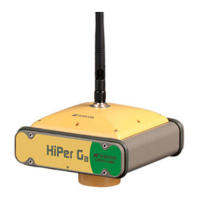Introduction
HiPer Ga/Gb Operator’s Manual
1-4
DGPS accommodates various implementation techniques that can be
classified according to the following criteria:
• The type of GNSS measurements used, either code-phase or
carrier-phase differential measurements
• If real-time or post-mission results are required. Real-time
applications can be further divided according to the source of
differential data and the communication link used.
With DGPS in its most traditional approach, one receiver is placed at
a known surveyed location and is referred to as the reference receiver
or base station. Another receiver is placed at an unknown location and
is referred to as the remote receiver or rover. The reference station
collects the code-phase and carrier-phase measurements from each
GNSS satellite in view.
• For real-time applications, these measurements and the reference
station coordinates are then built up to the industry standard
RTCM—or various proprietary standards established for
transmitting differential data—and broadcast to the remote
receiver(s) using a data communication link. The remote receiver
applies the transmitted measurement information to its observed
measurements of the same satellites.
• For post-mission applications, the simultaneous measurements
from reference and rover stations are normally recorded to the
receiver’s internal memory (not sent over communication link).
Later, the data are downloaded to computer, combined, and
processed.
Using this technique, the spatially correlated errors—such as
satellite orbital errors, ionospheric errors, and tropospheric
errors—can be significantly reduced, thus improving the position
solution accuracy.
A number of differential positioning implementations exist, including
post-processing surveying, real-time kinematic surveying, maritime
radio beacons, geostationary satellites (as with the OmniSTAR
service), and satellite based augmentation systems (WAAS, EGNOS,
MSAS).

